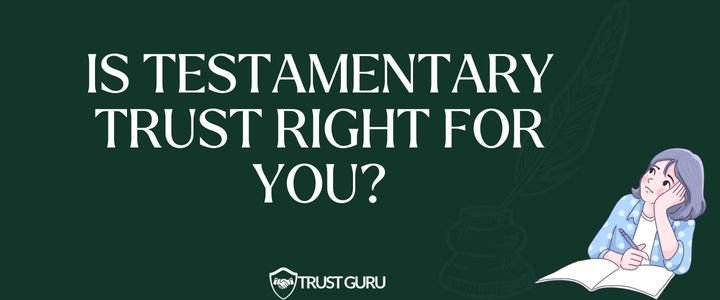When planning what happens to your assets after you’re gone, understanding your options is key—and one lesser-known but important tool is the testamentary trust. This type of trust, created through a will and activated after death, can help you control how your estate is distributed to your loved ones.
In this guide, we’ll break down what a testamentary trust is, how it works, and when it might make sense to use one. Whether you’re exploring ways to protect your family or comparing trust options, you’ll walk away with clarity—and confidence.
What you’ll learn:
- What Is a Testamentary Trust?
- Key Features and Benefits of a Testamentary Trust
- How a Testamentary Trust Is Created and Activated
- Testamentary Trust vs. Living Trust: What’s the Difference?
- Common Use Cases for a Testamentary Trust
- Is a Testamentary Trust Right for You?

What Is a Testamentary Trust?
A testamentary trust is a type of trust that’s created through a person’s will and goes into effect only after they pass away. Unlike a living trust—which is set up and managed during your lifetime—a testamentary trust is a will-based trust, meaning it’s part of your last will and testament.
It allows you to control how and when your assets are distributed to your beneficiaries after your death, offering a layer of protection and structure that a simple will may not provide.
A Simple Definition
Think of a testamentary trust as a set of instructions you leave behind—with a built-in manager—to ensure your assets are handled according to your wishes. It lets you leave money or property to someone, but with specific conditions attached.
For instance, you may want your child to receive their inheritance in stages, or you may want to designate funds to support a relative with special needs over time.
This type of trust offers more control than a straightforward will. It’s ideal for those who want to customize how their legacy is managed, especially when it involves young heirs or complex family situations.
How It Works
- Created through a will: You include the trust terms directly in your will. This outlines who will serve as the trustee, who the beneficiaries are, and how the assets should be managed and distributed.
- Becomes active after death: The trust doesn’t exist or take effect while you’re alive. It’s triggered only after your passing, making it a death-triggered trust or posthumous trust.
- Requires probate: Because it’s part of your will, the trust must go through the probate process before it becomes active. The court oversees the transfer of assets into the trust and ensures your wishes are legally carried out.
Example: Sarah, a single parent, wants to make sure her two kids are financially supported if something happens to her. She sets up a testamentary trust in her will that names her brother as trustee and specifies that the children can use the funds for education and living expenses until they turn 30. This gives her peace of mind knowing her estate will be handled responsibly, even after she’s gone.
Key takeaway: A testamentary trust is a powerful option for people who want to maintain control over their estate after death, especially when planning for children or loved ones who may not be ready to manage a large inheritance. While it requires probate, it provides structured, long-term protection for your legacy.

Key Features and Benefits of a Testamentary Trust
A testamentary trust isn’t just a legal document—it’s a flexible estate planning tool that gives you greater control over how your assets are distributed after your death.
While it may not be the right choice for everyone, it offers several advantages for individuals and families who want to ensure their wishes are carried out with structure and protection.
Benefits
Here are some of the key benefits of using a testamentary trust:
- Control Over Asset Distribution
You decide how and when your beneficiaries receive their inheritance. Whether you want to delay access until a certain age or set guidelines for how funds are used, a testamentary trust allows you to define the terms. - Designed for Minor Children or Dependents
If your beneficiaries are young or financially inexperienced, a testamentary trust can hold and manage assets on their behalf until they’re ready to take control. - Ongoing Protection for Heirs
This type of trust can help safeguard your beneficiaries’ inheritance from risks like creditors, poor financial decisions, or divorce. - Structured Oversight Through a Trustee
You appoint a trustee—someone you trust—to manage the trust and follow your instructions. This adds a layer of accountability and reassurance that your wishes will be respected.
When It Makes Sense
A testamentary trust is often a smart solution for people with more specific needs or family considerations. It may be the right fit if:
- Avoiding probate isn’t a top concern.
Since the trust is created through your will, it must go through probate. If you’re not actively trying to bypass the court process, this may not be a drawback. - You have young children, dependents with special needs, or a blended family.
Testamentary trusts are useful when inheritances need to be structured, delayed, or distributed carefully over time. - You value long-term structure and control.
This trust type provides ongoing guidance and safeguards that a simple will cannot offer.
Key takeaway: A testamentary trust offers structure, protection, and peace of mind—especially for families who want to support their loved ones while maintaining clear control over how their estate is handled.

How a Testamentary Trust Is Created and Activated
Understanding how a testamentary trust is set up and when it becomes active is essential to deciding whether it’s the right fit for your estate plan.
Unlike a living trust, which takes effect during your lifetime, a testamentary trust is tied to your will and becomes active only after your death—through a legal process called probate.
Created Through a Will
A testamentary trust is drafted as part of your last will and testament. In this section of your will, you can outline key details such as:
- Who the trustee will be—the person responsible for managing the trust
- Who the beneficiaries are—the individuals who will receive assets from the trust
- Any rules or conditions for how and when assets should be distributed (e.g., age-based releases, education-related expenses, etc.)
This structure allows you to tailor the trust to your family’s specific needs, from supporting minor children to providing lifelong support for someone with a disability.
Goes Into Effect After Death
A key distinction of a testamentary trust is that it does not exist while you’re alive. It is a death-triggered trust, which means it is:
- Activated only after your death
- Funded through probate, the legal process by which your will is validated and your assets are distributed
During probate, the court ensures that your will—including the trust provisions—is legally binding. Once approved, the trustee can begin administering the trust based on your instructions.
The Activation Timeline (At a Glance)
Here’s a simplified look at how the process unfolds:
Will is written → Death occurs → Probate begins → Testamentary trust is created and funded
Key takeaway: A testamentary trust is created through your will and only becomes active after you pass away. While it offers strong control and structure, it must go through probate before any assets are distributed—an important factor to consider when choosing the right estate planning approach.

Testamentary Trust vs. Living Trust: What’s the Difference?
When exploring your estate planning options, you’ll likely come across two common types of trusts: testamentary trusts and living trusts. While both serve the purpose of managing and distributing your assets, they function very differently—especially in terms of timing, flexibility, and probate involvement.
Understanding the distinctions can help you choose the structure that aligns best with your goals, family needs, and overall estate plan.
Key Differences
Here’s how the two compare in their fundamental structure and purpose:
| Feature | Testamentary Trust | Living Trust |
| When It’s Created | Included in a will; created after death | Created during your lifetime |
| Activation | Only takes effect after death | Becomes active immediately |
| Requires Probate | Yes – goes through probate before activation | No – designed to avoid probate |
| Cost to Set Up | Typically lower upfront cost | Higher initial cost due to setup complexity |
| Privacy | Public record (as part of probate) | Private – not filed in court |
| Flexibility | Limited once the will is executed | Can be updated or amended while alive |
| Control During Life | None – not effective until death | Full control over assets while alive |
As shown, the primary distinction is when each trust is created and how it interacts with the probate process. A testamentary trust is part of your will and must pass through probate before it’s enacted. A living trust, on the other hand, is designed to operate while you’re alive and typically avoids the court system altogether.
Pros and Cons of Each
Both trust types have their place in estate planning, and the best choice depends on your goals, your family situation, and how involved you want to be in managing your estate.
Testamentary Trust:
Pros:
- More cost-effective to create
- Suitable for straightforward planning needs
- Ideal for planning support for minor children or long-term dependents
Cons:
- Subject to probate (can be time-consuming and public)
- Cannot be changed after death
- Limited flexibility during your lifetime
Living Trust:
Pros:
- Avoids probate, saving time and money for your heirs
- Offers privacy and control during your lifetimeLiving trusts offer privacy and control during your lifetime, unlike testamentary trusts that are subject to probate.
- Can be amended as your life circumstances change
Cons:
- More complex and costly to set up
- Requires active management and funding
- May be more than what’s needed for simple estates
Key takeaway: While both testamentary and living trusts are valuable tools, they serve different purposes. A testamentary trust may suit those seeking a simple, will-based solution for future asset distribution, while a living trust is often better for those who want to streamline the process, maintain privacy, and avoid probate entirely.

Common Use Cases for a Testamentary Trust
While a testamentary trust isn’t the right choice for every estate plan, it can be an excellent solution for families who need to provide long-term structure, oversight, or special protections. Below are some of the most common scenarios where a testamentary trust makes practical and emotional sense.
Parents of Minor Children
If you have children who are still minors—or even young adults who may not be ready to handle a large inheritance—a testamentary trust allows you to manage how and when they receive financial support.
For example, instead of giving your 18-year-old full access to their inheritance, you can set milestones like distributing funds at age 25 or covering specific needs like education, housing, or medical expenses. The trustee manages the assets until those terms are met, ensuring that your child is cared for without risking financial missteps.
Second Marriages or Blended Families
Blended families often have more complex estate planning needs. A testamentary trust can help you strike a balance between supporting a current spouse and preserving assets for children from a previous relationship. You might also consider prenuptial and postnuptial trusts as part of a well-rounded marital protection strategy.
For instance, you might allow your spouse to use certain assets during their lifetime while ensuring the remainder goes to your children later. This structure provides clarity and protection, reducing the potential for future conflict or misunderstandings between family members.
Special Needs Dependents
If you have a child or dependent with a disability or long-term care needs, a testamentary trust can offer financial support without jeopardizing their eligibility for government assistance programs like Medicaid or SSI.
Because the assets are managed by a trustee and distributed according to specific rules, the trust can be tailored to complement—not disrupt—other forms of support, offering lifelong stability and security.
Pro Tip:
While living trusts are often preferred today for their ability to avoid probate and offer more flexibility, testamentary trusts still serve an important role—especially when your focus is long-term care, oversight, and structured inheritance.
Key takeaway: A testamentary trust is particularly valuable for families with young children, complex relationships, or long-term care needs. It gives you a way to plan with intention, ensuring your assets are used exactly as you envision—no matter what the future holds.

Is a Testamentary Trust Right for You?
Choosing the right type of trust depends on your unique goals, family situation, and how much involvement you want during your lifetime. A testamentary trust can be a great fit for some—but it’s not a one-size-fits-all solution. Here are a few important considerations to help you determine if this trust structure aligns with your estate planning needs.
Factors to Consider
- Are you okay with probate?
Since a testamentary trust is created through your will, it must go through probate before it becomes active. If avoiding probate is a top priority for you, this may not be the ideal route. - Do you prefer simplicity or long-term control?
Testamentary trusts are generally simpler and less expensive to set up than living trusts. However, they don’t offer the same level of flexibility or privacy. If your goal is to create a plan and let it stand without frequent changes, this structure may work well. - What types of assets and family dynamics are involved?
This trust type is especially helpful when you have minor children, dependents with special needs, or blended family situations that require structured inheritance. If your estate is relatively straightforward, it might be all you need.
Alternatives to Consider
If your goals lean more toward avoiding court involvement, maintaining privacy, or having more control while you’re alive, you might consider these alternatives:
- Living Trust: Allows you to manage your assets during your lifetime and transfer them without probate.
- Irrevocable Trust: Offers tax advantages and asset protection but comes with less flexibility once created.
Irrevocable and revocable trusts offer different levels of control, protection, and tax advantages—explore how they compare to determine if they’re a better fit than a testamentary trust.
Not sure which option fits your situation? That’s where we come in.
Ready to take the next step?
Book a free consultation with Trust Guru and get personalized guidance on building a plan that protects what matters most—without the overwhelm.
Key takeaway: A testamentary trust is a smart option for those who want simple, structured asset distribution after death—especially when caring for minors or managing complex family needs. But depending on your preferences, a living or irrevocable trust might offer more flexibility. Trust Guru can help you decide with clarity and confidence.
Conclusion
Estate planning doesn’t have to be overwhelming or intimidating. Whether you’re exploring your first trust or comparing different options, understanding how tools like a testamentary trust work can bring clarity and peace of mind. This type of trust offers structure, protection, and control—especially useful if you’re planning for young children, blended families, or long-term dependents.
While a testamentary trust may not be right for everyone, having some plan in place is always better than none. The most important step is getting started with guidance you can trust.
Start Your Estate Plan Today—The Simple, Expert-Guided Way
With Trust Guru, you don’t need to navigate legal complexities alone. Our team offers professional, transparent support to help you create a plan that reflects your wishes and protects your loved ones. Book your free consultation now.
Frequently Asked Questions (FAQs)
The main purpose of a testamentary trust is to control how and when your assets are distributed to beneficiaries after your death. It’s particularly useful for providing financial oversight for minor children, dependents with special needs, or heirs who may benefit from a structured inheritance plan rather than a lump sum.
A testamentary trust is created through your will and only goes into effect after your death. It must go through probate before being activated. A living trust, on the other hand, is created and managed while you’re alive, becomes effective immediately, and typically avoids probate altogether. Each has its own benefits depending on your estate planning goals.
No, a testamentary trust does not avoid probate. Because it is part of your will, it must go through the probate process before the trust is created and funded. If avoiding probate is a priority, a living trust may be a better fit.
You should consider a testamentary trust if you have young children, dependents with long-term care needs, or a blended family that could benefit from structured asset distribution. It’s also a practical option if you’re not concerned about avoiding probate and want a straightforward way to add financial control to your will.
Yes, but only while you’re alive. Because the testamentary trust is part of your will, you can update or modify it by revising your will. However, once you pass away and the will enters probate, the trust terms become fixed and can no longer be changed.













